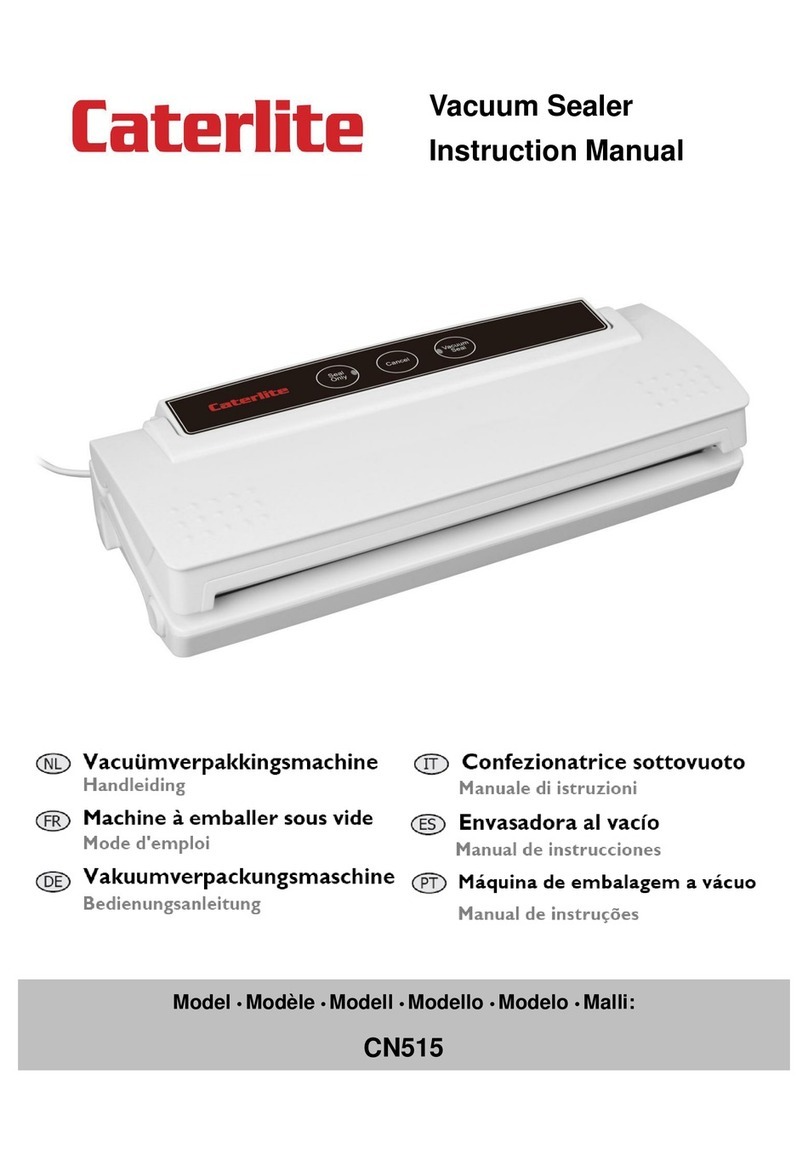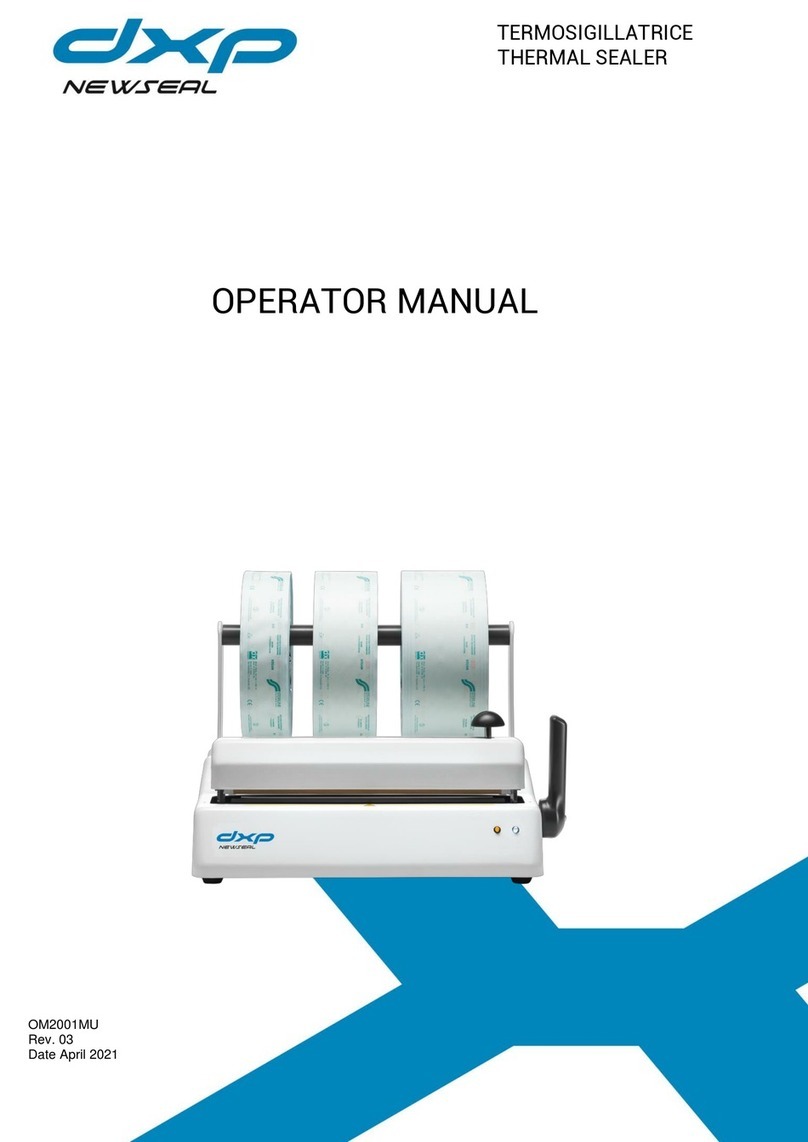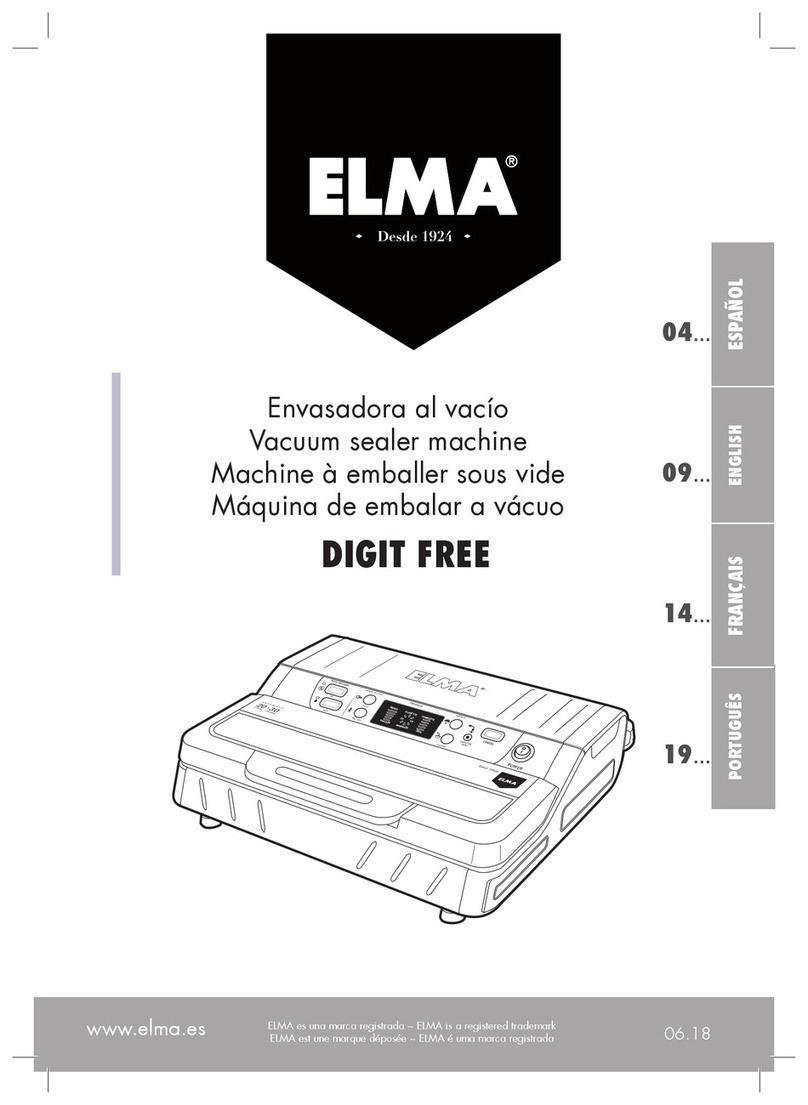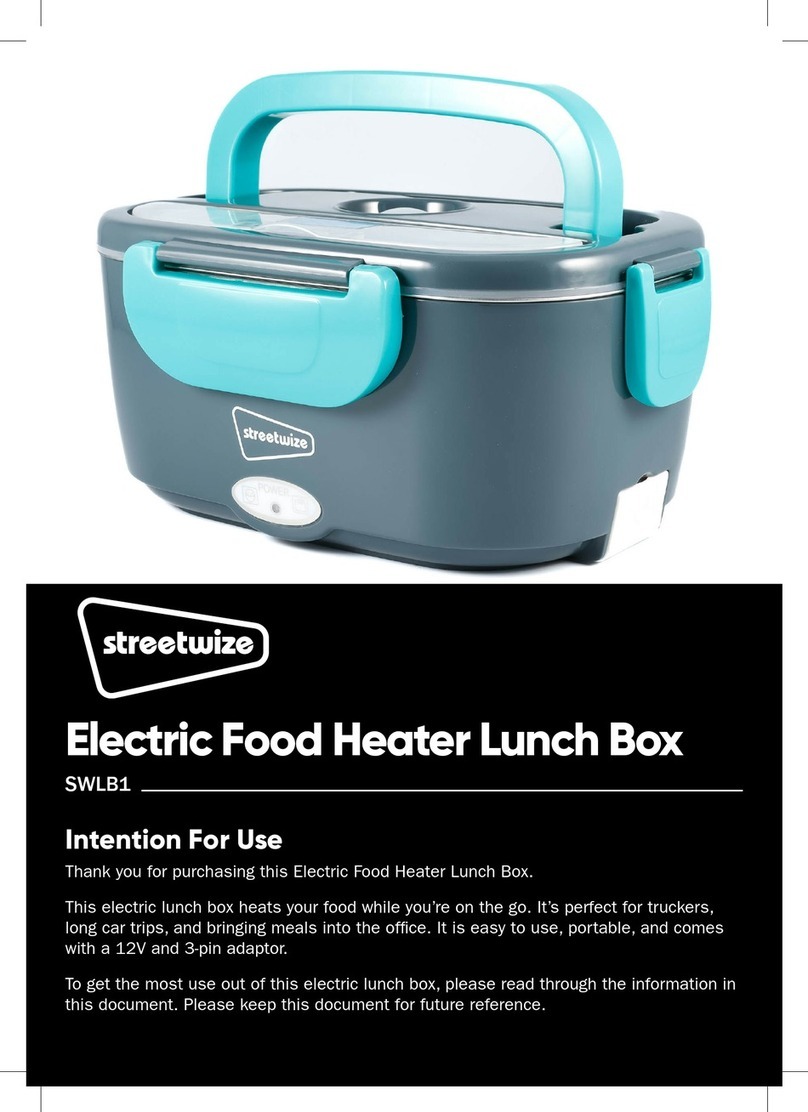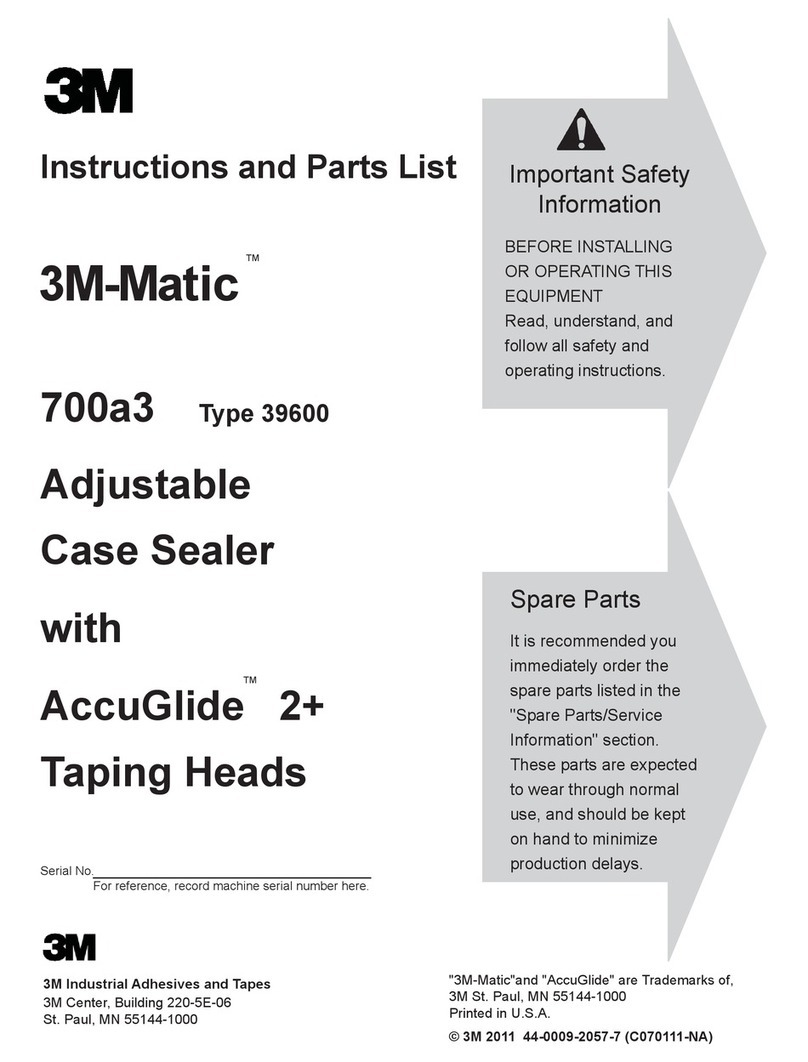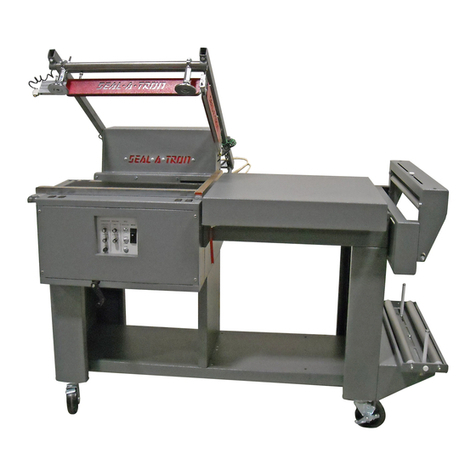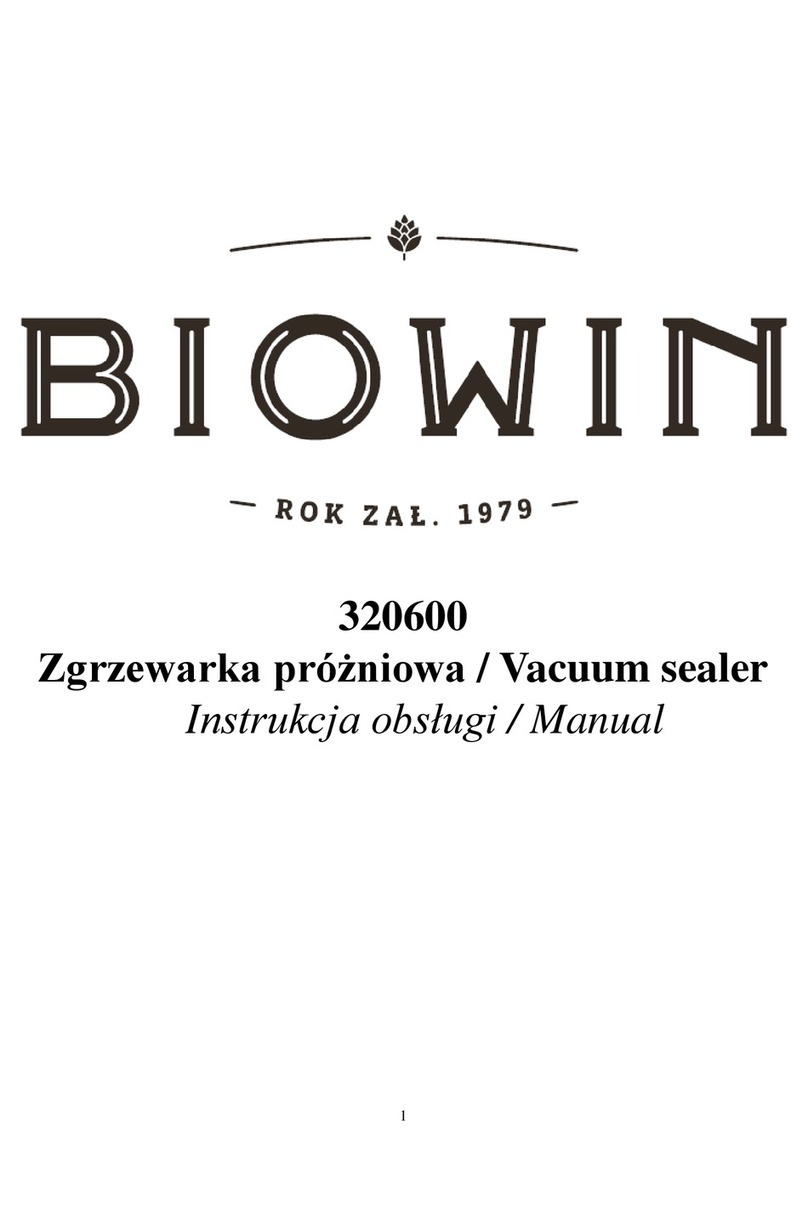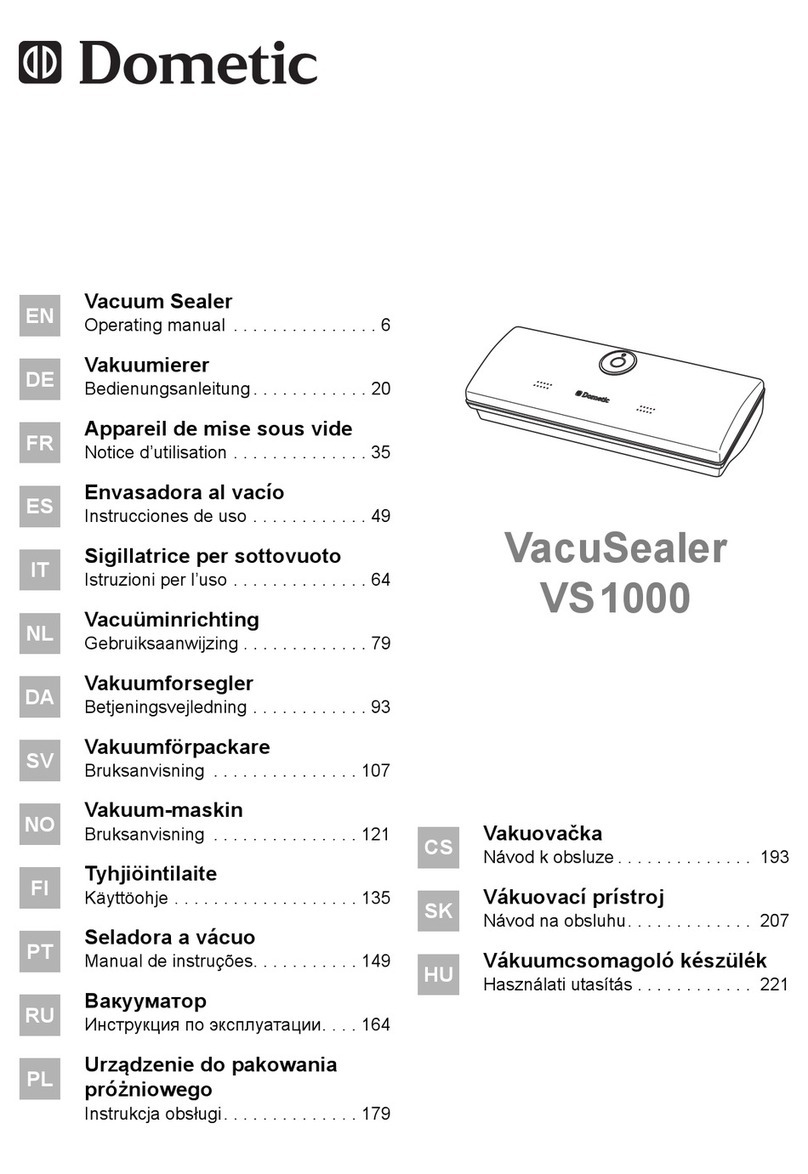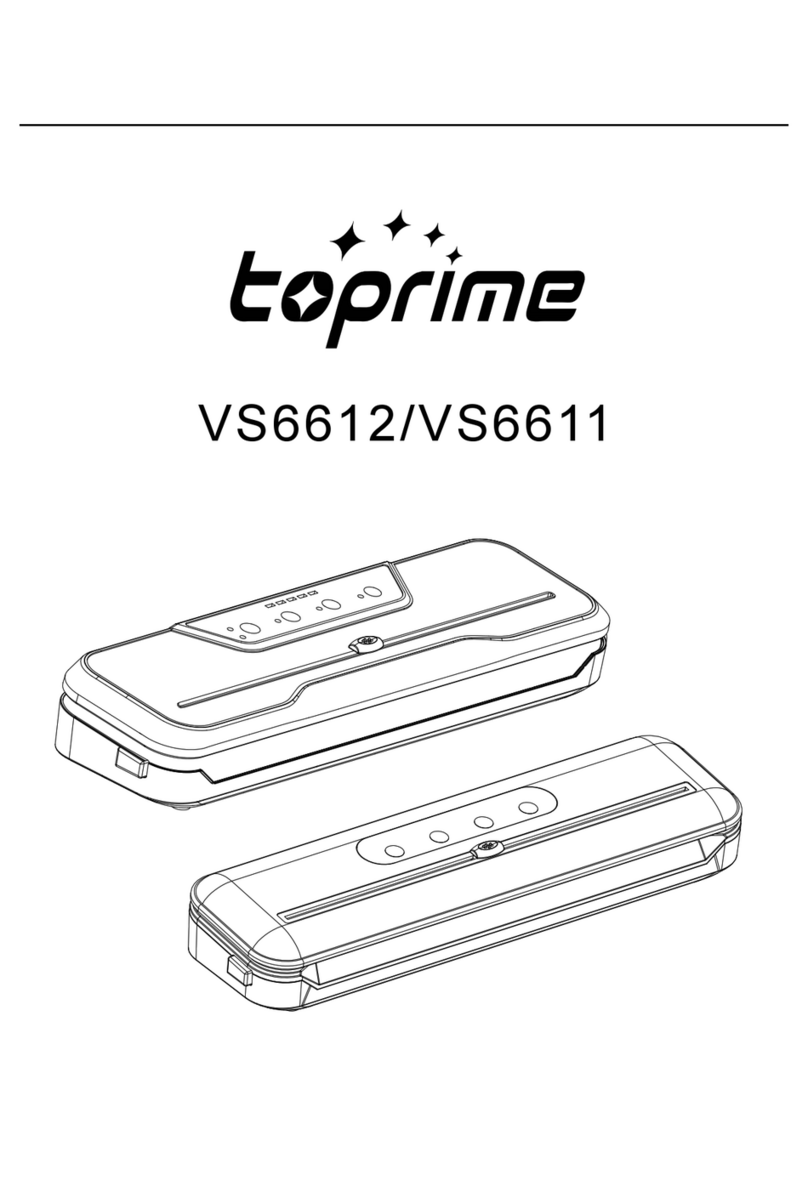Sirman SIGIX M20 Instruction manual

20
SERVICE CENTRE
AUTHORISED DEALER
Tray thermo-sealer CE professional
Instruction Manual, for Use and Maintenance
SIGIX M20
Ed. 03/2016

2 19
To proceed with the cleaning of the
machine from the outside, use a slightly
soaked sponge with a small quantity of
detergent and an odourless and non-
harmful sanitizer.
Do not use abrasive detergents, anti-
scaling detergent creams, solvents and
diluents; the residues of such products
may dangerously contaminate food
substances during following processing.
ATTENTION!
pH7
Fig. n°34
ATTENTION!
CHAP. 12 - DISMANTLING
12.1 - DECOMMISSIONING
If, for some reason, it is decided to disable the machine, make sure that it cannot
be used by any person: disconnect and cut electrical connections.
12.2 - WEEE Waste of electric and electronic equipment
In accordance with art.13 of the Legislative Decree dated 25 July
2005 ,n.151 ”Implementation of Directives 2002/95/CE, 2002/96/CE e
2003/108/CE, relating to the reduction of the use of hazardous substances
in electrical and electronic equipment, as well as to waste disposal”.
The symbol of the crossed out waste bin on the product and its packaging indi-
cates that at the end of its useful life, the product must be disposed of separately
from other waste.
Sorted waste disposal of products at the end of their useful life is organised and
managed by the manufacturer. The user should dispose of this equipment con-
tacting the manufacturer and following the system adopted by the latter to allow
the separate collection of the equipment at the end of its service life.
The suitable recycling for a further conveyance of the dismantled equipment, to
recycling, to treatment and to environmentally compatible disposal contributes to
avoid possible negative effects on the environment and on health and promotes
the re-use and/or recycling of materials, of which the equipment is made.
The illegal disposal of a product is punishable according to the laws
currently in force.

18
Fig. n°33
CHAP. 11 – ROUTINE CLEANING
11.1 - GENERALS
- Machine cleaning is an operation, which must be carried out, in case of contact
with the processed product.
- The tray sealers must not be cleaned with high pressure water jet cleaners or
water jets, but with neutral detergents (pH 7). Any other detergent product is
forbidden. Tools, scrubbing brushes and other may damage the surface of the
machine.
Before performing any cleaning operation, it is necessary to:
- disconnect the power supply plug from the mains to completely isolate
the rest of the system and wait for it to cool off.
11.2 – MACHINE CLEANING
The cleaning of the drawer must be carried out in case of need and it must be
performed with hot water and with the support of a sponge. Carefully dry each
element, at the end of the cleaning operation.
Error Cause Solutions
E1 Wait for the machine to be in the READY
mode to seal the tray correctly.
E2 A series of consecutive
“beep” signals during
sealing
The sealing operation has not been
completed correctly It is advisable to
perform the operation again.
CHAP. 10 – ISSUES AND SOLUTIONS
(See Fig. n°33)
10.1 – POSSIBLE ERRORS
WAIT 4.0 175°
0001 130°
READY 4.0 175°
0001 130°
3
FOREWORD
This manual has been drafted in order to provide the Customer with all the information
on the machine and on the relating safety regulations, as well as all use and
maintenance instructions, allowing to use the means in the best way possible,
preserving efficiency intact in the course of time.
This manual must be kept and preserved intact until machine disposal.
This manual is delivered to the staff assigned to use the machine and perform the
routine maintenance.
INDEX OF CHAPTERS
CHAP. 1 - MANUAL page 5
1.1 - PURPOSE
1.2 - USERS
1.3 - USE AND PRESERVATION
1.4 - MANAGEMENT AND RESPONSIBILITY
CHAP. 2 – INFORMATION ON THE MACHINE page 6
2.1 - GENERAL PRECAUTIONS
CHAP. 3 – TECHNICAL SPECIFICATIONS page 7
3.1 - SAFETY DEVICES INSTALLED ON THE MACHINE
3.1.1 - Safety electrical devices
3.2 - WARNING SIGNS
CHAP. 4 – ABOUT THE MACHINE page 9
4.1 - DESIGN FEATURES
4.2 - DESCRIPTION OF THE MACHINE
4.3 - COMPOSITION OF THE MACHINE
CHAP. 5 – TRASPORT PACKAGING AND UNPACKAGING page 10
5.1 - PACKING
5.2 - CHECK OF THE PACKAGING UPON RECEIPT
5.3 - UNPACKAGING
CHAP. 6 – TECHNICAL DATA page 12
6.1 - SIZE REQUIREMENT, WEIGHT AND FEATURES
CHAP. 7 – INSTALLATION page 13
7.1 - POSITIONING
7.2 - ELECTRICAL CONNECTION
7.2.1 - Monophase sealer
7.3 - WIRING DIAGRAM MONOPHASE 230V
CHAP. 8 – USE OF THE MACHINE page 14
8.1 - POSITIONING OF THE FILM
8.1.2 - Positioning of the mould
8.2. - PRELIMINARY CHECKS

4
CHAP. 9 – USE OF THE MACHINE page 15
9.1 - STARTING THE MACHINE
9.1.2 - Setting the use parameters
9.1.3 - Sealing – procedure
CHAP. 10 – ISSUES AND SOLUTIONS page 18
10.1. - POSSIBLE ERRORS
CHAP. 11 – ROUTINE CLEANING page 18
11.1 - GENERALS
11.2 - CLEANING OF THE MACHINE
CHAP. 12 - DISMANTLING page 19
12.1 - DECOMMISSIONING
12.2 - WEEE WASTE ELECTRICAL AND ELECTRONIC
EQUIPMENT LEVELS
17
RUN 2.3 175°
0006
4. Lower the welding head until it closes
completely, after hearing a “beep”
signal the sealing procedure starts for
the duration previously set (Fig. n°31).
5. The display will show the machine
status on “RUN” mode as well as the
elapsed seconds of the cycle (Fig. n°
31).
6. Upon reaching the sealing time set,
you will hear two consecutive “beeps”
warning that the operation has been
completed.
7. Shall the welding head be open before
the completion of the sealing, it will
emit a series of fast “beep” signals to
warn that the operation has not been
completed. It is recommended to
repeat the operation.
8. Lift the welding head.
9. Pull out the tray by hand in the side
openings (Fig. n°32) ATTENTION do
not touch the welding plate.
10.Now, it is possible to carry out a new
cycle.
Fig. n°31
Fig. n°32
3. Pull the film correctly above the tray to seal (Fig. n°29-30).
PAY ATTENTION to the knife for the cut of the film!
Fig. n°29 Fig. n°30

16
9.1.3 - Sealing – procedure
The machine is ready only if the display shows the “READY” mode.
(Fig. n°26)
1.Verify that the film reel is correctly in-
serted (read par. 8.1).
2.Insert the tray on the appropriate slot
and, then, load the product to seal in-
side the tray requiring sealing (Fig. n°
28).
ATTENTION: top plate very hot!
- The sealer displays the status of the
machine (a), the time for the sealing
of the tray (d), the preset temperature
(b), the current temperature of the
welding plate (e) and the number of
cycles (c) (Fig.n°25).
- In the “STOP” mode, press the
“MENU” key (ref. 3 fig.n°23) to modify
the time, press it again to modify the
temperature. Use the UP (ref. 6 fig. n°
23) and DOWN (rif. 5 fig. n°23)
buttons to modify the parameters.
- To reset the number of cycles, press
twice the “UP” button (rif.6 fig. n°23),
resetting can be carried out only in
the "STOP” mode.
- Pressing the “ON/OFF” button (rif. 2
fig. n°21), the sealer turns on, the
machine status wil pass from "WAIT”,
it will start to heat up the welding
plate until it reaching the set
temperature (Fig. n°26).
- Once the temperature is reached, the
machine is ready to seal with the set
configurations (Fig. n°27). The
machine status will read "READY”.
Fig. n°27
Fig. n°28
READY 4.0 175°
0001
a
c
STOP 4.0 175°
0001 105°
Fig. n° 25
b
e
d
WAIT 4.0 175°
0001 130°
Fig. n°26
READY 4.0 175°
0001
5
1.1 - PURPOSE
- The purpose of the Manual consists in providing the instructions as well as the
information, to scrupulously follow for a correct use of the machine and for the
protection and safety of the operator, who must interact with it. The Manual
describes the use of the machine, as provided by the project as well as the
technical features of the machine, provides for instructions on how to move it,
for an appropriate and safe installation, assembly, adjustment and use; it pro-
vides for information relating to the maintenance interventions as well as the
information required to order the spare parts. The Manual clearly shows the
uses, which are not allowed, of the machine, highlighting the residual risks,
with indication of the safety prescriptions to control them.
1.2 - USERS
The Manual is intended to be used by professional and suitably trained person-
nel and, specifically by:
- Machine operators
- Maintenance engineers
- Electrical maintainers
1.3 - USE AND PRESERVATION
- Each machine model is sold with its own Instruction Manual. The manual forms
an integral part of the machine and it must be preserved in good condition until
the machine is dismantled.
- THE MANUAL MUST BE PRESERVED IN A SAFE, DRY PLACE, PRO-
TECTED AGAINST DIRECT SUNLIGHT AND IT MUST ALWAYS BE AVAIL-
ABLE FOR CONSULTATION, IN PROXIMITY TO THE MACHINE.
- In case of transfer of the machine, the Manual must be conveyed to the new
owner.
1.4 - MANAGEMENT AND RESPONSIBILITY
This Manual represents the current status of the machine’s technique and can-
not be considered inappropriate in case of updates of the model, occurred after
the issue of the same Manual. The Manufacturer reserves the right to update
products and manuals, with no obligation to update manuals and previous pro-
duction. The Manufacturer shall hold the rights of intellectual property of this
Manual and it shall forbid its integral and partial disclosure, in any form (print,
copies, microfilms, or other means), as well as the processing, reproduction or
dissemination by electronic systems, towards private individuals or corpora-
tions without its approval. The User is responsible for the management of the
Manual for the entire machine life and will provide for its destruction only upon
disposal of the same machine. Any requests for further copies of this document
must be regularised with a purchase order sent to the Manufacturer.
CHAP. 1 – THE MANUAL

6
CHAP. 2 – INFORMATION ON THE MACHINE
2.1 – GENERAL PRECAUTIONS
Although they may seem predictable, the general precautions are essential for
the installations, the use and the maintenance as well as for any inconveniences
with relating solutions.
- The machine has been designed for the sealing of trays for food use,
containing packageable food.
- It is strictly forbidden to use flammable and/or harmful material.
- The Manufacturer shall be relieved from all responsabilities in the following
cases:
- the machine is used by unauthorized personnel;
- components are replaced with non-original ones;
- the instructions, contained in this manual, are not carefully followed;
- the surfaces of the machine are cleaned with inappropriate products.
- Take good care of this manual for
future information or consultations
(Fig. n°1).
- The machine must be used only by
trained personnel, who must
perfectly know the safety
regulations, contained in this
manual.
- In case of personnel turnover,
training must be provided
beforehand.
- Do not allow the machine to be used
by children or incompetent
individuals, and, in any case, by
untrained individuals (Fig. n°2).
- During intervention for routine
maintenance or machine cleaning,
carefully assess the residual risks.
- During service or cleaning, keep
your mind focused on the ongoing
operations.
- For machine cleaning, do not use
corrosive or flammable substances
(Fig. n°3); use only neutral
products (pH 7).
- For cleaning, carefully follow the
instructions of the chapter: "Routine
cleaning".
- Do not wash the machine with water
jets, with rough or abrasive means, Fig. n°3
pH7
Fig. n°2
Fig. n°1
15
1
Fig. n°23
2
36 5 4
Legend:
1 Main ON/OFF switch 4 Display
2 ON/OFF Key 5 DOWN key
3 MENU Key 6 UP key
Fig. n° 24
1
CHAP. 9 – USE OF THE MACHINE
9.1 – STARTUP OF THE MACHINE
9.1.2 – Setting of the use parameters:
- Pressing the general switch
"ON/OFF" (1) the sealer turns on
(Fig. n°24).
8.2 – PRELIMINARY CHECKS
Before proceeding with the testing, place the film correctly (see par. n°8.1), then,
test the functioning with the following procedure (see Fig. n°23):
- turn on the machine by selecting the general switch “ON/OFF” (1) on the posi-
tion “ON”;
- The display (4) turns on and the wording “STOP” is displayed.
- Pressing the “MENU” key (3) once, it is possible to modify the sealing time, by
pressing again, it will be possible to modify the temperature of the welding
plate to reach.
- After setting the parameters according to one’s needs, pressing the “ON/OFF”
key (2), the welding plate will start to heat up.
- Wait for it to reach the set temperature.
- Shut the machine off by selecting the general switch “ON/OFF” (1) on the
"OFF" position.

14
CHAP. 8 – USE OF THE MACHINE
8.1 – POSITIONING OF THE FILM (See Fig. n° 21)
ATTENTION! use only sealable film.
Before placing the film reel (a) on the machine, verify the sizes of the same (see
Chart n.1).
Remove any protection material from the film reel and place it at the centre of the
suitable rollers (b), carefully minding for the initial part of the film, which must be
unrolled.
Take the initial edge of the film, pass it over the first roller (c) and, then, slowly
pulling it downwards, passing it under the roller (d) and, then, under the film-
pressing sheet (e). Pull it in case of need until covering the entire tray to seal.
Fig. n°22
Fig. n°21
(d)
(b)
(a)
(e)
b b
a
c
d
8.1.2 Positioning of the mould
(See Fig. n°22)
Before starting to seal, it is necessary
to verify whether the mould is placed in
the correct position.
Place the mould in the appropriate
space and match the holes of the same
with the two pegs present on the sealer.
7
which may ruin the surfaces, do not
dip it in water or in other liquids.
- Do not leave the machine exposed to
harmful agents: sun, rain, sprays,
humidity, ice (Fig. n°4).
- Do not pull the machine or the power
supply cable (Fig.n°5), to disconnect
the plug from the power source.
- Regularly check the status of the
power supply cable; a used or, in any
case, a non-intact cable represents a
serious electrical danger.
- Shall the machine remain unused for
long periods, before using it, an
“Assistance Centre” must check it.
- Shall the machine give the impression
of or show a malfunction, it is
recommended to shut it off and to not
use, to not intervene directly for
repairs and to contact the “Assistance
Centre”, shown on the back of this
manual.
- Do not keep the machine uselessly
on. Disconnect the plug from the power source when the machine is not being
used.
- CAUTION! NEVER introduce your hands inside the hot machine, the
welding plate may cause serious burns.
Fig. n°4
Fig. n°5
CHAP. 3 – TECHNICAL SPECIFICATIONS
3.1 – SAFETY DEVICES INSTALLED ON THE MACHINE
3.1.1 – Electrical safety devices
As for the electrical safety devices, the machine described in this manual com-
plies with the:
- low voltage directive CEE 2006/95;
- electromagnetic compatibility directive 2004/108.
Despite the CE professional tray sealer is provided with the regulation measures
for electrical protections (both during the operation mode and during the cleaning
and maintenance stage), yet, there are some RESIDUAL RISKS which cannot
be completely removed, recalled in this manual under the entry ATTENTION.
They relate to the danger of burns, deriving from the contact with hot parts of the
machine and cut danger deriving from the contact with the blade of the slitter.

8
WARNING!
- Before performing any cleaning or maintenance operation, disconnect
the plug of the machine from the electrical power supply network.
3.2 – WARNING SIGNS
Danger label, showing the achievement of high temperatures
on the welding plate.
Avoid any type of contact.
Label, showing the cut danger or other injuries of the same
type in the slitter.
Fig. n°6
Fig. n°7
Fig. n°8
cutter
sealing plate
13
7.1 – POSITIONING
The surface, on which the machine must be installed, must take into account the
bearing sizes, shown on Tab. 1, and, therefore, have a sufficient width; it must
lean on a well leveled surface, far from water and heat sources, suitable air-
conditioning and lighting, in compliance to the space required for use and protec-
tion.
Moreover, the machine must be placed in an environment provided with max.
75% non-saline humidity and having a temperature ranging from +5°C to +35°C;
in any case, in environments, not entailing malfunctions of the same.
7.2 – ELECTRICAL CONNECTION
Verify that the information on the technical plate-serial number (Fig. n°19), in the
delivery documents, and on the order match; if not, contact the supplier for ex-
planations.
At this point, verify that the system is compliant with regulations and that the ca-
ble and the grounding system are perfectly functioning.
MOD: machine model
V: power supply
Hz: frequence
A: amperage
W: power
KG: weight
ANNO: date of production
SERIAL NO: n° serial number
Fig. n°19
CHAP. 7 - INSTALLATION
7.2.1 – Monophase sealer
The machine is provided with a power supply cable, having a section of 3x1mm²;
length ≅3m and a "SCHUKO" plug. Connect the sealer to the 230 V. - 50 Hz
voltage, by interposing a thermal magnetic circuit breaker of 10A, ΔΙ= 0.03A.
7.3 – WIRING DIAGRAM MONOPHASE 230V.
Fig. n°20
RESISTANCE

12
CHAP. 6 - TECHNICAL DATA
6.1 – SIZE REQUIREMENT, WEIGHT, FEATURES ...
MODEL U.m. M 20
Power watt 900
Supply 230V/50Hz
Film reels mm 200
Size Max tray mm 260x190
A x B mm 257x525
Cmm 306
Dmm 496
Net weight kg 18
TAB. n°1 – SIZE REQUIREMENTS AND TECHNICAL FEATURES
ATTENTION:
The electrical features, with which the machine is compatible, are shown in a
plate applied on the rear of the machine.
Fig. n°18
9
CHAP. 4 – ABOUT THE MACHINE
4.1 – CONSTRUCTION FEATURES
The machine mainly consists in a stainless steel structure AISI 304, whereas the
welding plate consists in Teflon-coated aluminium.
4.2 – DESCRIPTION OF THE MACHINE
Tray sealers have been designed and implemented by the same firm with the
exact purpose of sealing food inside trays for food use and assure:
- maximum safety as for use, cleaning and maintenance;
- maximum hygiene, achieved owing to a detailed selection of the materials,
which enter into contact with the food;
- firmness and stability of all the components.
4.3 – MACHINE COMPOSITION
Legend
1 Main ON/OFF switch 7 Slot for mould
2 Film reel support rollers 8 Cutter
3 Control board 9 Film-pressing sheet
4 Sealing plate 10 Sealing head
5 Tray mould 11 Tray chamber
6 Handle 12 Power cord
6
10
8
2
3
5
4
1
7
12
11
9
Fig. n°9

10
Dimensions
AxBxC (mm) Gross weight
(Kg)
620x380x400 22
CHAP. 5 – TRASPORT PACKAGING AND UNPACKAGING
5.1 – PACKAGING
The packaging, in which the machine
is shipped, is made up of (Fig. n°10):
cardboard box, protection nylon mate-
rial and cardboard inserts. Therefore,
they shall be disposed separately and
in compliance with the regulations in
force in the installation country.
A B
C
Fig. n°11
Heavy packaging. Do not lift manually
without the support of minimum two
people (Fig. n°13).
Do not leave the packaging exposed to
humidity and rain (Fig. n°12).
Fig. n°12
Fig. n°13
Fig. n°10
11
Do not stack up more than two
packagings. (Fig. n°14).
WARNING!
Fig. n°14
All the operations must be carried out by
the specialized technical personnel (Fig.
n°16).
WARNING!
Fig. n°16
5.3 – UNPACKAGING
Open the box (Fig. n°17), remove the
protection nylon material from the ma-
chine and lift it up carefully.
Fig. n°17
5.2 – CHECK OF THE PACKAGING UPON RECEIPT
Fig. n°15
Do not overturn the packaging!! Upon transportation, make sure that it is
grabbed firmly from the 4 corners (thus keeping it parallel to the floor).
Upon received of the package, shall it not
feature external damages, proceed with its
opening and check that all the material is
present inside. On the contrary, if upon
delivery the parcel features signs of
mistreatment (Fig. n°15), collision or fall, it
is necessary to inform the courier about the
damages, and within three days from the
delivery date, shown on the documents,
draw up an accurate report on any
damages undergone by the machine.
Table of contents
